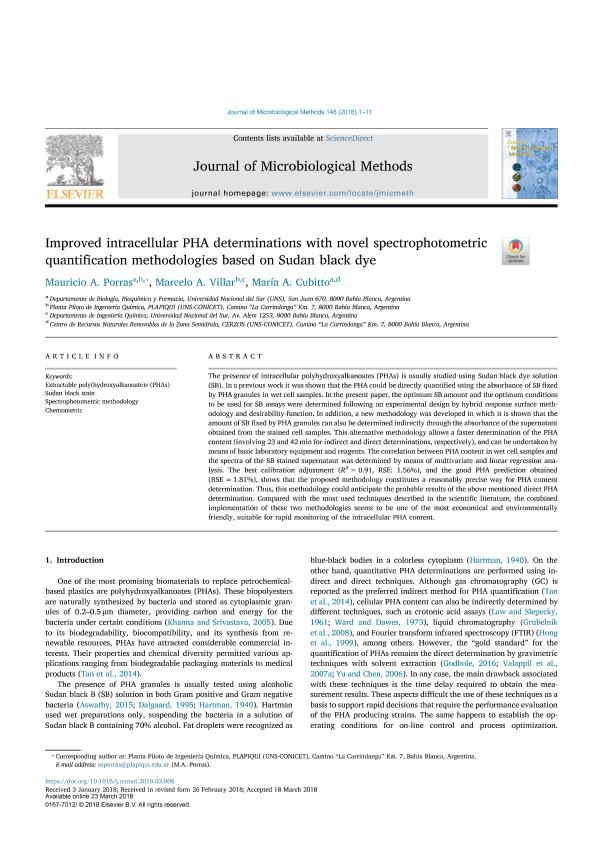Artículo
Improved intracellular PHA determinations with novel spectrophotometric quantification methodologies based on Sudan black dye
Fecha de publicación:
05/2018
Editorial:
Elsevier Science
Revista:
Journal of Microbiological Methods
ISSN:
0167-7012
Idioma:
Inglés
Tipo de recurso:
Artículo publicado
Clasificación temática:
Resumen
The presence of intracellular polyhydroxyalkanoates (PHAs) is usually studied using Sudan black dye solution (SB). In a previous work it was shown that the PHA could be directly quantified using the absorbance of SB fixed by PHA granules in wet cell samples. In the present paper, the optimum SB amount and the optimum conditions to be used for SB assays were determined following an experimental design by hybrid response surface methodology and desirability-function. In addition, a new methodology was developed in which it is shown that the amount of SB fixed by PHA granules can also be determined indirectly through the absorbance of the supernatant obtained from the stained cell samples. This alternative methodology allows a faster determination of the PHA content (involving 23 and 42 min for indirect and direct determinations, respectively), and can be undertaken by means of basic laboratory equipment and reagents. The correlation between PHA content in wet cell samples and the spectra of the SB stained supernatant was determined by means of multivariate and linear regression analysis. The best calibration adjustment (R2 = 0.91, RSE: 1.56%), and the good PHA prediction obtained (RSE = 1.81%), shows that the proposed methodology constitutes a reasonably precise way for PHA content determination. Thus, this methodology could anticipate the probable results of the above mentioned direct PHA determination. Compared with the most used techniques described in the scientific literature, the combined implementation of these two methodologies seems to be one of the most economical and environmentally friendly, suitable for rapid monitoring of the intracellular PHA content. presence of intracellular polyhydroxyalkanoates (PHAs) is usually studied using Sudan black dye solution (SB). In a previous work it was shown that the PHA could be directly quantified using the absorbance of SB fixed by PHA granules in wet cell samples. In the present paper, the optimum SB amount and the optimum conditions to be used for SB assays were determined following an experimental design by hybrid response surface methodology and desirability-function. In addition, a new methodology was developed in which it is shown that the amount of SB fixed by PHA granules can also be determined indirectly through the absorbance of the supernatant obtained from the stained cell samples. This alternative methodology allows a faster determination of the PHA content (involving 23 and 42 min for indirect and direct determinations, respectively), and can be undertaken by means of basic laboratory equipment and reagents. The correlation between PHA content in wet cell samples and the spectra of the SB stained supernatant was determined by means of multivariate and linear regression analysis. The best calibration adjustment (R2 = 0.91, RSE: 1.56%), and the good PHA prediction obtained (RSE = 1.81%), shows that the proposed methodology constitutes a reasonably precise way for PHA content determination. Thus, this methodology could anticipate the probable results of the above mentioned direct PHA determination. Compared with the most used techniques described in the scientific literature, the combined implementation of these two methodologies seems to be one of the most economical and environmentally friendly, suitable for rapid monitoring of the intracellular PHA content.
Archivos asociados
Licencia
Identificadores
Colecciones
Articulos(PLAPIQUI)
Articulos de PLANTA PILOTO DE INGENIERIA QUIMICA (I)
Articulos de PLANTA PILOTO DE INGENIERIA QUIMICA (I)
Citación
Porras, Mauiricio Ariel; Villar, Marcelo Armando; Cubitto, María Amelia; Improved intracellular PHA determinations with novel spectrophotometric quantification methodologies based on Sudan black dye; Elsevier Science; Journal of Microbiological Methods; 148; 5-2018; 1-11
Compartir
Altmétricas




